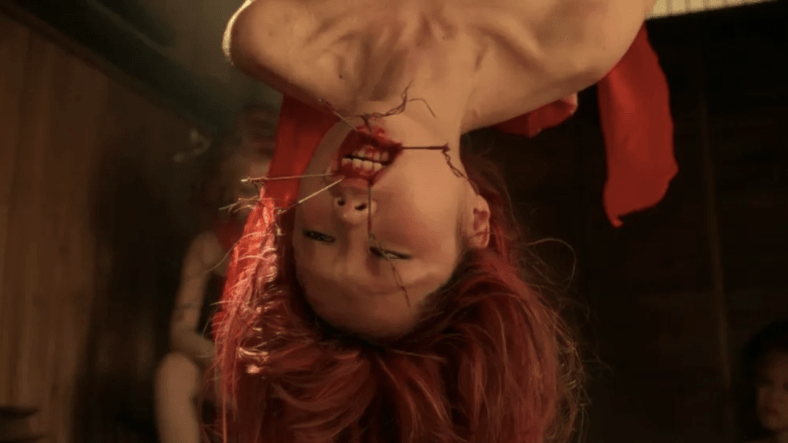Mick Garris Reveals The Truth Behind Controversial ‘Masters of Horror’ Episode

Mick Garris is a horror icon, known for Sleepwalkers, Critters 2, The Shining (1997), and so much more. And being a horror icon means you get to know others of your ilk, directors and writers known for terrifying audiences with their tales of the macabre. To celebrate this range of talent, Garris created the anthology film series Masters of Horror, which ran for two seasons on Showtime. Each season consisted of 13 60-minute episodes directed by the likes of John Carpenter, Tobe Hooper, Don Coscarelli, Dario Argento, and even Garris himself.
But one episode in particular has gained notoriety as it was never aired by Showtime. It was Imprint, directed by controversial horror director Takashi Miike. His film followed a 19th-century tourist who returns to Japan to find the sex worker he fell in love with years prior. However, when he arrives, he discovers she suffered a horrific fate involving torture and painful death. The script is based on the story “Bokkee Kyotee” by Shimako Iwai.
Garris wanted to bring Miike onto the series to both expand its scope internationally and because he loved Miike’s 1999 film Audition. “When it came time to put all of the people together for masters of horror, we didn’t wanna get just a bunch of older white guys <laugh> who had made classic horror,” he told Dread Central.
“We asked female directors to do it, too. But we got turned down by people who didn’t want to be considered horror directors,” said Garris. “They had made Oscar-winning films in the meantime, after beginning in the horror field. [They] were trying to move on to other genres and did not want to be associated with the term horror.”
So, they managed to make a connection with Kadokawa Studios in Japan, who had previously worked with Miike. It was the perfect match. Now it was time to get to work.
“As with all of the films, the director called all the shots. [Miike] wanted to do an adaptation of this story by [Shimako Iwai]. And so he got it together. We got the script translated and everything was approved,” said Garris. Yes, you read that right, the script was approved by both Garris and Showtime.
According to Garris, Showtime gave them “a series of five criteria that we needed to meet to not cross the line.” Those criteria included things such as no adults having sex with children, no adults killing children, and no male frontal nudity. “The script did not break any of those taboos. And indeed the show that resulted did not break any of those taboos either,” said Garris.
But the company changed their tune when they saw the complete film. “They were so freaked out by its intensity. You know, things that you read on a page, once you see them in your face, on a screen, it has an entirely different feel to it. So they said no way,” said Garris.
Showtime wanted edits made to sanitize the film. But, that went against the entire philosophy of the series. For Garris, the filmmaker was God and got the final cut; no studio interference allowed. So, the Masters of Horror team pushed back against Showtime without offering to make any edits.
“We wanted to be true to the philosophy of the show. We said, look, none of your five rules are broken here. And we think you should honor your agreement to show what we promised to deliver, because they had no problem with any of the other ones,” said Garris. So, Imprint never aired on the network.
The director went on to say, “I found out later after the fact, like months, maybe even a year after the fact that Miike and the producer would’ve made cuts to the show to make his break into American television. However, we didn’t want him to.”
Showtime’s decision had a ripple effect when it came to distributing the episode via physical media, too. At the time, Walmart was a major distributor when it came to DVD sales. And when each Masters of Horror episode was released, it was also released on DVD, which subsequently meant it was sold in Walmarts across the country. But when the big-box store heard of Showtime’s reaction to Imprint, they refused to sell it.
“You could buy it on Amazon. You could buy it at other video outlets, but even then video outlets were not as widely available. So we got screwed by Walmart and by Showtime,” said Garris.
While Imprint may show one side of Miike, Garris saw another when he was on set in Japan.
“I went to Japan for most of the shoot and the strange thing to me was Miike is a very kind and protective guy,” he said. Garris saw Miike being very protective, especially of his younger actor. He made sure to show her that everything was rubber, or just a doll. “He was very cautious around her,” said Garris.
When asked if this is still the most disturbing film he’d ever seen, Garris told us:
It’s certainly one of them. Maybe that’s still true, you know, but my job was not to satisfy my sensibilities. My job was to be a cheerleader for these creative people and to create things from their imaginations to suit their tastes. And so I was encouraging, I think it’s a beautiful film. But it is hard to take.
Despite the controversy, Imprint‘s ban led to a slew of great press. Garris said, “There were a lot of people talking about Showtime. How bad must [Imprint] be? How much of a test of your mettle was it to watch this?” As they say, any press is good press.
If you’re interested in experiencing Miike’s twisted horror vision, it’s now much easier to find. Imprint is available to purchase, as well as streaming for free on Tubi.
Categorized:News

